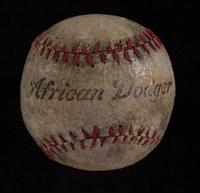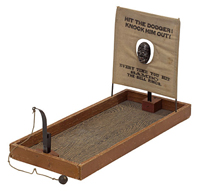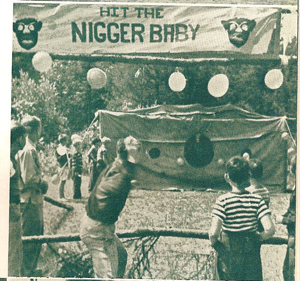Jim Crow Museum
1010 Campus Drive
Big Rapids, MI 49307
[email protected]
(231) 591-5873
Somebody told me that whites used to pay to throw balls at blacks at the circus. Is
this true?
--Stephanie S. - Columbia, Missouri

At the end, thirty feet or so from the counter that closed the entrance, a grinning Negro face bobbed and grimaced through a hole in the back curtain painted to represent a jungle river. The Negro's head came right out of the spread terrific jaws of a crocodile. "Hit the nigger in the head, get a good ten cent seegar," the barker said. "Three balls for a dime, folks. Try your skill and accuracy. Hit the nigger baby on the head get a handsome cane and pennant" (Stegner, 1957, p. 47).
This was a common chant at numerous carnivals, fairs, and circuses across the United States throughout the late 19th century until the mid 1940s, as Americans took part in one of their favorite pastimes, "African Dodger."
The African Dodger, also known as "Hit the Nigger Baby" or "Hit the Coon" was as commonplace in local fairs, carnivals, and circuses as Ferris wheels and roller coasters are today. The purpose of the game was to hit the target with a ball-with one of your three throws-and win a prize. It sounds like a common carnival target game, but there was one unsettling part of the game, namely, the game's target was a real live human being, a "negro" human being. In St. Louis in 1913, it was reported that carnival organizers were "unable for hours today to secure an 'African Dodger' who would allow baseballs to be thrown at his cranium at the usual rate of three for 5 cents;" the reason was that future Hall of Fame fastball pitcher Walter Johnson was rumored to be at the fair ("Don't Want", 1913). The game was so popular nationwide that newspapers mentioned the African Dodger game along with trained animals, illusionists, penny arcades, merry-go-rounds and magic shows in the list of a carnival's attractions. Dodgers made headlines when they were seriously and horrifically injured-otherwise, they were nameless victims.
In 1904 in New York, the Meriden Daily Journal reported how a dodger was smashed in the nose by a professional baseball player. The Journal reported that Albert Johnson dodged "fifty or sixty cents" worth of balls thrown by "Cannon Ball" Gillen of the Clifton Athletic club. Finally Johnson "exposed his head and face a little farther than usual" and was caught by a curve ball that left him unconscious. The article, which was written as a play-by-play commentary on the incident, concluded with the report that it "will probably be necessary to amputate the nose in order to save Johnson's life" ("Hit African", 1904).
But this was not the only report of serious injuries to the dodger. There were numerous reports of such incidents; for example, at the Sheraden Methodist Protestant Church street fair in Pittsburgh, John Jones "failed to dodge" and was hit "squarely in the eye" ("Ball Hits", 1916). In Ohio, Grady Williams was struck in the eye by a stone by someone who "stood to one side and threw a stone at the negro" ("Threw Stone", 1915).
In Connecticut, Walter Smith was hit "with such force that several of the dodger's teeth were knocked out, and the ball was locked so securely within the negro's mouth that it had to be cut to pieces before it could be removed" ("His Mouth", 1908).
In Hanover, PA, William White was assaulted by local baseball players who brought their own heavy balls and "hit the 'coon' nearly every time." The reporter described how "courageously" White took the punishment and wrote that the "negro was pretty well used-up." Only after this, do we find out that the injuries sustained by White were internal and "may prove fatal" (" 'Coon Hitting' ", 1908).
At an Elks Lodge Jubilee in Washington DC, just 17 miles from the White House, the "visiting Elks were royally entertained" as "'nigger babies' were hit with baseballs until they were unable to maintain their upright position..." ("Elks Jubilee", 1908).
There may be no better example of the pervasiveness and brutality of the African Dodger game in American society than an advertisement in the Providence News on September 11, 1924.
Wants African Dodger to Face Balls at Club Fair
Do you want to earn a few precious dollars on the evening of September 19 and 20?
If you do and if you are not at all particular as to what happens to your head why apply at Room 10 in the building at 144 Pine street. Ask for Charlie and tell him you "saw his ad in the paper". Charlie is looking for a lion-hearted and hard-headed young man who will act as an African dodger at the big carnival to be staged by the West Barrington Community Club. The reward? That is a little matter that you can adjust with Charlie. He will treat you fairly and will see that you reach the Rhode Island Hospital safely in the event that that [sic] one of the baseballs comes in contact with your head.
We beg your pardon for not detailing the duties of an African dodger. He just puts his head through a hole in a big piece of canvass and permits the aforesaid head to be used as a target by young men who toss baseballs.
One day last week an African dodger was killed in Elizabeth, N.J., and the week before a dodger was killed in Hackensack, but don't permit these deaths to influence you. ("Wants African Dodger", 1924).
The African Dodger game was widespread in American society, in every part of the country. If you could not make it to the fair, you could purchase for $.69 an African Dodger table game, which featured a caricatured black face poking through a canvas reading "Hit the Dodger! Knock Him Out! Every Time You Hit Sambo The Bell Rings" ("Bloomingdales", 1893).

But how could this all be? How could such a barbaric practice be such an integral part of a "civilized" society? How could Americans justify this practice? Were there any objections?
One response to objections to the brutality of the African dodger game was to summon authorities to provide "scientific" findings on the topic. A short article in The Wayne County Democrat cited "authorities on anthropology" who "state that the negro has a very heavy and massive cranium constituting a bony arch of great resisting power. One scientist refers to the 'common habit of negroes, of both sexes in butting like rams'[which]...indicates that a negro's head bones have defensive strength unknown in the Caucasian race." The newspaper assures its readers that the dodger doesn't mind. "He seems cheerful about it." The players of the game, the ones who throw the ball, are just men with a "man's desire to display his powers", particularly in front of "women friends." The article finally concludes that until there is evidence that shows "fractured skulls or brain contusions" or until the dodger takes issue himself, the game will continue. A final warning is provided to the dodger who may be considering a new line of work that "He might regret to lose a daily wage that comes with less effort than manual labor" ("The Black Dodger", 1913).
After all, what could be so bad about a game that was an "innocent" sport ("Large Crowd", 1907) and a game that was "fun for the small boys and the grown-ups as well" ("Dodger", 1907)? A game played by Governors ("Preparing", 1912), famous ball players like Ty Cobb ("Bob Thayer", 1911) and Babe Ruth (Wagenheim, 1974, p. 35), what could be wrong with that?
When legislation was presented in 1915 to ban some forms of the game at Coney Island, the headline read: BAN ON "BONEHEAD" HITS. The proposed ban was framed as "depressing news" for those who may be unable to participate in the "soothing exercise of hitting with a baseball the head of an 'Ethiopian' as it protrudes from a hole in a canvas sheet." But don't just feel sorry for the players, understand that "many persons who have no more profitable use for their heads will join the army of the unemployed" if the bill is passed and Africans are no longer allowed to dodge ("Ban", 1915).

In 1911, some carnivals ushered in a new game for the "progressive era" called the African Dip, the precursor to the dunk tank. The game was "arranged that every time a baseball hits the target a colored man, seated upon a bar, is thrown into a large pool of water. It's said to be lots of fun..." ("It's Called", 1911). This new game didn't entirely replace the African Dodger. Versions of the original African Dodger were still found in the 1950s. Some carnivals and fairs decided to use targets that resembled African Americans instead of using real people. Promoters sold entire family doll racks that were used as targets at Amusement parks (A. J. Smith Mfg. Co., 1914). The development of Amusement parks in permanent locations increased the popularity of the African Dip game because it was hard to travel with the African Dip dunk tank. Riverview Amusement park in Chicago Illinois, was well known for their popular African Dip attraction, which was a staple there until the late 1950s.
It may be hard to imagine a world where such barbaric games were accepted and played, and to understand why people would allow themselves to be targets. This is another example of the complexities of relationships during the Jim Crow era. The idea that African Americans were sub-humans was prevalent and widely accepted. Religious speakers, politicians, and scientists all agreed and "proved" that the African was a "less evolved" creature and therefore not subject to humane treatment. Almost everything in American society pointed to a hierarchical structure, whites on top and blacks at the bottom.
With everyday objects, forms of entertainment, advertising and public policies confirming
this hierarchy, it is possible to see how whites came to believe they were superior
and how some blacks could internalize these images, practices, attitudes and policies
and come to see themselves as inferior and to accept the role of target. It's also
difficult for many to see the negative impact of racist games when playing them is
associated with fondness of yesteryear. One of the most popular attractions at zoos
during this time was the "Negro Village" or "Human Zoo", but that's a topic for another
day.
Franklin Hughes
Diversity & Inclusion / Jim Crow Museum
2012
Blacks as targets video resource https://www.youtube.com/watch?v=l4oCL99mrRk
Smith Mfg. Co. (1914, March 21). Amusement devices [Advertisement]. The Billboard,
p. 76.
http://fultonhistory.com/Newspaper%2015/Billboard/Billboard%201914/Billboard%201914%20-%200873.pdf
Ball hits African Dodger. (1916, July 22). The Gazette Times, p. 1.
http://news.google.com/newspapers?nid=J-ba04ztB30C&dat=19160722&printsec=frontpage&hl=en
Ban on "bonehead" hits. (1915, February 10). The Washington Herald, p. 6.
http://chroniclingamerica.loc.gov/lccn/sn83045433/1915-02-10/ed-1/seq-6/
The black dodger. (1913, September 19). The Wayne County Democrat, p. 3.
http://news.google.com/newspapers?nid=wXCFTzxW9NYC&dat=19130919&printsec=frontpage&hl=en
Bloomingdale's (advertisement). (1893, December 14). The Evening World, p. 8.
http://chroniclingamerica.loc.gov/lccn/sn83030193/1893-12-14/ed-4/seq-8/
Bob Thayer's sporting gossip. (1911, June 2). Washington Times, p. 15.
http://chroniclingamerica.loc.gov/lccn/sn84026749/1911-06-02/ed-1/seq-15/
'Coon Hitting' peril. (1908, September 22). The Philadelphia Record, p. 4.
http://news.google.com/newspapers?nid=QDEWnZBrHwAC&dat=19080922&printsec=frontpage&hl=en
Dodger is an expert but sometimes he is hit. (1907, October 31). Richland Shield and
Banner, p. 6.
http://news.google.com/newspapers?nid=cInq4TRmCz8C&dat=19071031&printsec=frontpage&hl=en
Don't want craniums pelted with balls by Walter Johnson. (1913, July 19). Omaha Daily
Bee, p. 2.
http://chroniclingamerica.loc.gov/lccn/sn99021999/1913-07-19/ed-1/seq-2/
Elks Jubilee ends. (1908, June 19). The Washington Herald, p. 14.
http://chroniclingamerica.loc.gov/lccn/sn83045433/1908-06-19/ed-1/seq-14/
His mouth full of ball. (1908, August 6). The Philadelphia Record, p. 1.
http://news.google.com/newspapers?nid=QDEWnZBrHwAC&dat=19080806&printsec=frontpage&hl=en
Hit African Dodger. (1904, August 17). The Meriden Daily Journal, p. 6.
http://news.google.com/newspapers?nid=h-OLoDDdPfcC&dat=19040817&printsec=frontpage&hl=en
It's called the "African dip" and it's a new one out at Flemington. (1911, July 28).
Trenton True American, p. 1.
http://news.google.com/newspapers?nid=6g4f2aSzPAQC&dat=19110728&printsec=frontpage&hl=en
Large crowd, ideal weather. (1907, September 19). Custer County Republican, p. 4.
http://chroniclingamerica.loc.gov/lccn/sn94055463/1907-09-19/ed-1/seq-4/
Preparing for the fair. (1912, August 7). Red Bank Register, p. 1.
http://rbr.mtpl.org/data/rbr/1910-1919/1912/1912.08.07.pdf
Stegner, W. (1957). The Big Rock Candy Mountain. New York: Sagamore Press, Inc.
Threw stone at African Dodger; Hit him in eye. (1915, May 16). Youngstown Vindicator,
p. 10.
http://news.google.com/newspapers?nid=pqgf-8x9CmQC&dat=19150515&printsec=frontpage&hl=en
Wagenheim, K. (1974). Babe Ruth: His life and legend. New York: Praeger Publishers.
Wants African Dodger to face balls at club fair. (1924, September 11). The Providence
News, p. 19.
http://news.google.com/newspapers?nid=Dnd9Dw9jpwAC&dat=19240911&printsec=frontpage&hl=en